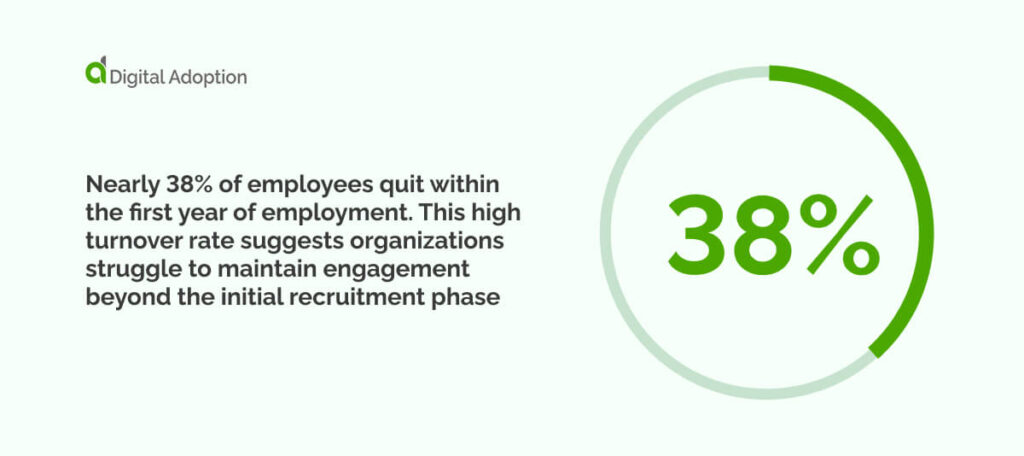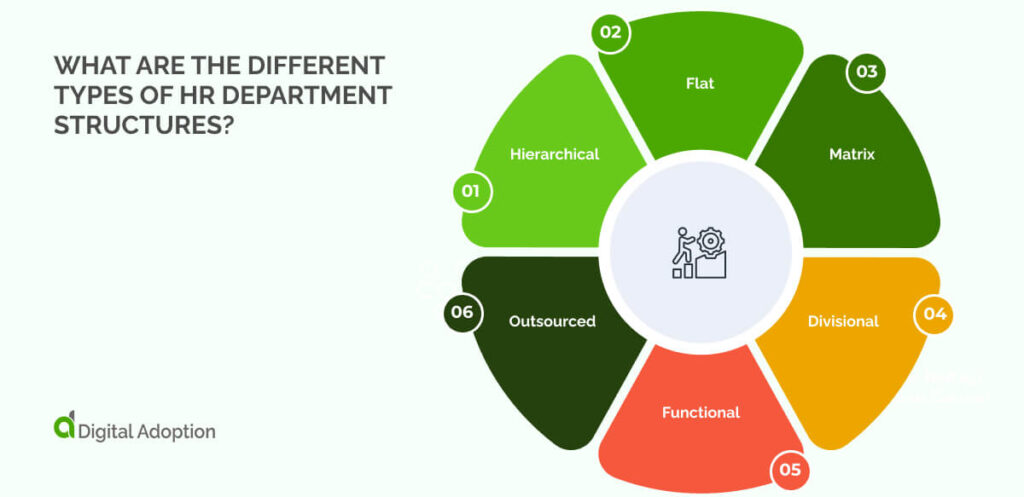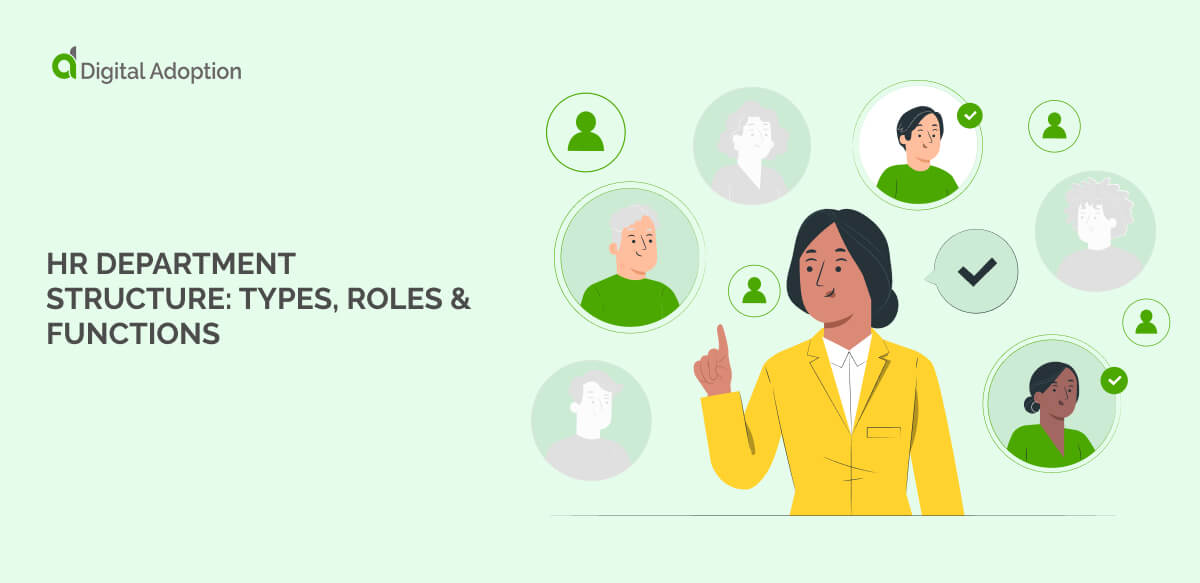It’s no surprise that HR departments with transparent processes are better at talent management.

However, nearly 38% of employees quit within the first year of employment. This high turnover rate suggests organizations struggle to maintain engagement beyond the initial recruitment phase.
When structured properly, HR departments can optimize internal processes to address both recruitment challenges and retention issues throughout the employee lifecycle. This involves creating specialized teams dedicated to talent acquisition, employee onboarding, and retention.
A clear structure helps HR teams prioritize tasks and ensures everyone knows their responsibilities.
This article will explore the modern HR department structure. We’ll look at the different types, roles, and functions. We will also show you how to build your own HR department structure tailored to your organization’s size.
What is an HR department structure?
An HR department structure is a framework that outlines the hierarchy, roles, and responsibilities of HR personnel.
This structure shows how HR activities are organized and who handles HR tasks and decisions. It’s also called an HR organizational chart, which shows the department’s roles and reporting lines.
A well-designed HR department structure is key to understanding employees’ needs. An effective structure creates clear communication paths and helps HR professionals gather insights from all levels of the organization.
What are the different types of HR department structures?

Many different types of organizational structures exist. This is especially true for HR departments that are required to adapt to an organization’s needs and culture.
HR structures vary based on company size, industry, geographical spread, and strategic priorities.
Let’s take a look at the HR department structures most modern businesses use:
Hierarchical
A hierarchical structure has a clear chain of command. HR managers sit at the top and assistants at the bottom. It establishes a hierarchy where each level reports to the one above. Roles are defined, creating an atmosphere where authority and decision-making flow from top to bottom.
Advantages:
- Clear job definitions
- Managed decision-making
- Simple reporting lines
Disadvantages:
- Possible slow progress
- Less adaptable
- May limit teamwork and open collaboration
Flat
A flat HR structure has few management layers. HR staff reports directly to the department head, which helps leaders decide quickly and promotes open discussion. It suits small companies or startups and gives staff more freedom. Firms must adjust the flat structure to maintain efficiency and clear authority lines.
Advantages:
- Quick decision-making
- Clear communication
- High employee autonomy
Disadvantages:
- Limited growth opportunities
- Potential for overwhelmed leadership
- Difficult to maintain in large organizations
Matrix
Matrix HR structures blend skill expertise with project flexibility. Employees report to both role leads and project heads. This splits resources more evenly. A two-way reporting system helps share knowledge and mix ideas. It fits groups needing flexible HR help for varied projects.
Advantages:
- Flexible resource allocation
- Encourages cross-functional collaboration
- Efficient use of specialized skills
Disadvantages:
- Potential for conflicting priorities
- Complex reporting relationships
- Requires strong communication skills
Divisional
HR teams in divisional structures work with specific business areas or regions. Each part has its own HR staff to meet its needs. This helps HR understand and support each area better. HR can adapt plans within the company’s overall structure. This setup allows HR to focus on what each division needs.
Advantages:
- Tailored HR support for each division
- Fast decision-making within divisions
- Clear focus on division-specific needs
Disadvantages:
- Potential duplication of efforts
- Inconsistent practices across divisions
- Higher overall HR costs
Functional
In functional HR, experts work in teams on tasks like hiring or pay. Skilled leaders guide each team, growing knowledge and improving employee performance. This setup works for groups with complex HR needs. It helps establish policies and provide services. It also creates centers of excellence within HR to boost overall employee satisfaction.
Advantages:
- Deep expertise in specific HR areas
- Efficient, standardized processes
- Clear career paths for HR specialists
Disadvantages:
- Potential for silos
- May lack a business unit perspective
- Can be slow to adapt to changes
Outsourced
Some companies hire outside firms for HR tasks. This lets them use expert skills and tools they don’t have in-house. Outsourcing HR can save money and help growth, especially for small businesses. It helps companies use best practices while focusing on their main goals.
Advantages:
- Saves money for small companies
- Provides expert HR skills
- Lets the company focus on the main business
Disadvantages:
- Less control over HR work
- May lack company-specific knowledge
- Can be slow for urgent needs
What are the different roles in an HR department structure?
Now that you understand the different types of HR department structure, let’s move on to the various roles you can find in an HR department:
HR managers
HR managers, such as the chief human resources officer (CHRO), oversee all aspects of human resources. They lead the wider HR team, shape policies, and work with other departments. Their job is to build a strong workforce, handle employee issues, and ensure the company follows labor laws. They also play a key role in company culture and growth.
HR generalists
HR generalists do many different HR tasks, not focusing on just one area. Their work includes hiring, training, and helping with employee issues. These professionals also help with company rules. Generalists work with all types of employees and need to be good at solving problems and talking to people.
Recruiters
Recruiters find and hire new staff for companies. These experts check job seekers, look at resumes, and do interviews. They bring skilled people to the company, know the job market well, and can match workers to the right jobs. Good recruiters also stay updated on hiring laws and company needs. Their work is key to growing and improving the workforce.
Compensation and benefits administrators
Compensation specialists handle employee pay and benefits. They run pay systems and manage health and retirement plans. These experts ensure the company offers good pay packages. They keep up with pay laws and help workers understand their choices. Their work is key to keeping employees happy and the company competitive.
Learning and development specialists
Learning specialists focus on helping workers grow. They create and run training to boost employee skills. These experts help staff do better in their jobs and get ready for new roles. They use many ways to teach and often work with bosses to plan worker growth. Their goal is to make the workforce stronger and more skilled.
People data analysts
People data analysts analyze worker information to help companies make good choices. They study hiring, job performance, and why people leave. Their findings help make HR work better and shape company plans. These experts must be good with numbers and explain tricky data simply. Their work helps bosses understand the workforce better.
HRIS specialists
HRIS specialists run HR computer systems. They manage software that tracks worker info, pay, and benefits. These experts make sure HR staff use the systems right and safely. Companies that use digital systems for worker data need HRIS specialists. They help keep employee information organized and easy to use.
What are the functions of an HR department structure?
Every HR department functions a little differently. However, some core functions are common across most HR departments and form the foundation of effective workforce management.
Let’s take a closer look at the various functions of an HR department structure:
Employee well-being
Employee well-being is among the top priorities for HR professionals. A Workhuman study found that employee wellness leads to less burnout, better social ties, more belonging, and a greater sense of thriving at work. These findings highlight a link between worker health and positive workplace outcomes.
Recruitment
After worker well-being, HR focuses on hiring top talent. This key goal helps a company grow. HR teams work to build a strong staff that fits the company’s needs and culture. Good hiring keeps the company moving forward.
Performance management
Performance management and goal tracking are key HR tasks. Companies must ensure workers do well and handle their workload to stay competitive. If staff fall behind, the performance team steps in. They provide useful feedback and support to help employees improve.
Employee relations
Employee relations build good ties between workers and employers. This includes communication, solving conflicts, and fair treatment. Good relations boost mood, work output, and loyalty. These teams handle workplace issues and enforce rules. They create a workplace where staff feel valued and listened to.
Company culture
Company culture is vital for shaping the workplace atmosphere and employee experience. A big part of company culture is instilling shared values, beliefs, and behaviors that define an organization. HR is key in building and maintaining this culture through internal policies and programs.
Compensation and benefits administration
A big part of attracting and keeping top talent is offering good pay and benefits. HR teams put a lot of effort into creating full packages to draw new workers. This helps a company stand out and look better than rivals for jobs needing similar skills.
Training and development
Training and growth are key tasks for HR teams. It’s crucial to make sure workers feel at ease in their jobs and have the right skills to do well. The training team helps employees learn and grow. They also support staff when they move to new roles in the company.
Employee health and safety
Worker health and safety is a top concern for HR teams. As rules change, this group must follow health and safety laws. Their job covers many areas, from job training to fire drills. They make sure the workplace is safe for all employees.
How to build an HR department structure
Now that you understand the varied roles in an HR department structure, it’s time to learn how to build one of your own.
We will explore how to build an effective HR department structure tailored to different organizational sizes.
Let’s take a look at the specific approaches and considerations for small, medium, and large businesses:
Small business HR department structure
Small-sized businesses should focus on the following:
Versatile HR generalist
A versatile HR generalist is an all-rounder who helps out in different capacities. For small businesses, this means hiring someone with general HR skills without needing specialized staff for each area. This is a great starting point for companies who don’t have the resources to invest in extra staff but want to cover essential personnel functions.
Scalable policies and procedures
Start small and build scalable policies that pay off in the long term. A huge part of HR management is creating policies that can grow with your company. As your company grows, these policies should adapt smoothly without needing a complete overhaul.
Compliance and regulation management
Governance, risk, and compliance are important in any HR department structure. This is especially true for small businesses without dedicated legal teams. HR professionals must stay current with labor laws, workplace regulations, and industry-specific requirements.
Medium business HR department structure
Medium-sized businesses should focus on the following:
Specialized HR roles
Medium-sized businesses should use specialized HR roles to develop expertise in key areas. This approach emphasizes better knowledge management. It benefits HR functions like recruitment, training, or employee relations. Specialized roles improve HR performance and employee satisfaction.
Multiple HR generalists
HR generalists also work well in medium-sized companies. They handle various HR tasks and provide good value for money. Several generalists can maintain flexibility and ensure HR needs are met. This setup promotes workload distribution and provides backup support during busy periods or staff absences.
Strategic employee-management communication
Communication between employees and management is required for a healthy workplace. It involves creating open channels for feedback and addressing concerns. Build trust by aligning staff with organizational development objectives and focusing on communication.
Large business HR department structure
Large-sized businesses should focus on the following:
Streamlined HR processes
For large businesses, the focus should be on streamlining your HR processes. When building an HR department structure, it can be easy to become misaligned and overlook top priorities. Streamlining HR processes such as recruitment and onboarding improves efficiency and consistency across the organization.
Comprehensive talent acquisition
Talent acquisition is vital for large businesses that generally have higher turnover rates. Maintaining and recruiting talent is fundamental, especially in larger-scale operations. Companies should invest heavily in talent management initiatives across the organization. Doing so helps support growth and ensures that HR teams remain focused on innovation.
Extensive training and development
Training and development are among the most important goals for modern HR teams. When new processes are introduced, employee training plans become a priority. Businesses must ensure they get the most value for money out of their employees. Extensive training and development equip employees to do their jobs in the most efficient way possible.
Tailoring your HR structure for success
It goes without saying that HR department structures can get pretty complex. That said, the nuances of each organization’s needs and culture will shape the ideal HR setup.
Today, businesses must invest heavily in their HR department processes and structure to remain competitive.
Gartner says that 46% of HR leaders report recruiting as their top priority. This demonstrates the need for HR departments to structure themselves to prioritize and optimize their recruitment efforts.
A well-crafted HR structure boosts employee satisfaction, streamlines operations, and aligns company goals.
While it can be challenging to understand at first, the benefits of a well-designed HR department far outweigh the initial effort.
It often leads to long-term organizational success and a thriving workplace culture.
People Also Ask
-
What is an HR department?An HR department manages all things related to people in a company. They handle hiring, training, pay, benefits, and employee issues. HR teams work to create a pleasant work environment, follow labor laws, and help the company reach its goals through its workforce.
-
What is an HR organizational chart?An HR organizational chart shows how the HR department is set up. Its a visual map of who reports to whom in HR. The chart includes different HR roles and their levels, from the top HR leaders to specialists. It also helps employees understand the HR teams structure.
-
What are the five main areas of HR?HR covers key functions that manage employees and support company goals. While departments may organize these differently, most include these five main areas: 1. Recruitment and staffing 2. Training and development 3. Compensation and benefits 4. Employee relations 5. Compliance and safety









